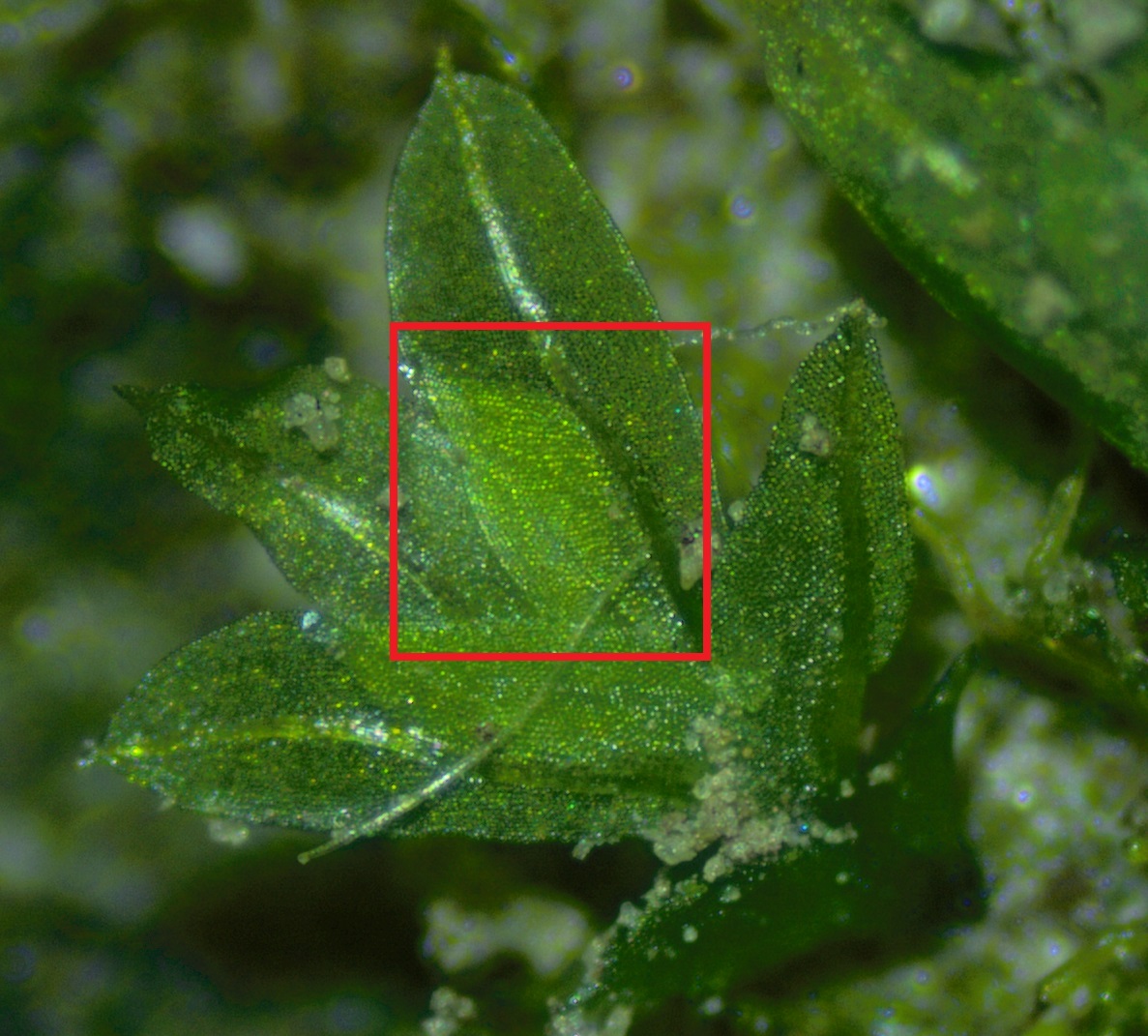If your moss fits the description of 1a. click the species name which appears in blue to continue to the species page. If your moss does not fit that description move on and read 1b. In some instances instead of a species name at the end of a description a genus name will be present. Click on the genus and a further species key will be presented.
Use of a hand lens is very helpful.
1a. Grows in aquatic environments, generally found submerged, or at least partially submerged in flowing water.—2.
1b. Grows terrestrially, on trees, to dry sandy soils, can be found in wet seepage areas—7.
2a. on older growth branches the leaves are often missing, with just a the costa remaining—Hygroamblystegium fluviatile
2b. Branches do not appear to be missing leaves with purpose—3.
3a. Leaves have a pocket-like structure on one side of the costa see Figure 1—Fissidens fontanus
3b. Leaves do not posses a pocket like structure on either side of costa—4.
4a. Costa is double—Hygrohypnum molle
4b. Costa is single or absent—5.
5a. Leaves lack a costa, are strongly keeled (like the Bottom of a v-shaped boat) of from base to apex, and are translucent when wet—Fontinalis antipyretica
5b. Leaves have a costa, and are not strongly keeled and, are not translucent—6
6a. Branches appear julaceous (branches smooth, cylindrical, leaves closely overlapping, in worm-like appearance) Leaves ovate, spreading slightly when wet, —Platyhypnidium riparioides.
6b. Branches not julaceous, leaves are lanceolate to ovate, wide spreading when wet, —Leptodictyum riparium
7a. Growing in a vertical dendroid fashion from a horizontal stem—8.
7b. Not growing in a vertical dendroid fashion from a horizontal stem—10
8a. Generally found growing on rocks or logs, branches clustered at apex of secondary stem, branches generally curve down towards the ground with non-pleated leaves—Thamnobryum alleghaniense.
8b. Generally found growing on soil, with branches spreading in various directions with pleated leaves—9.
9a. Leaves have a small lobe projection on both edges of their base and are normally between 1.5 mm to 2.5 mm long —Climacium americanum.
9b. Leaves have no lobe structures at their base and are normally between 1.5 mm to 3 mm long—Climacium dendroides.
10a. Leaf costa is single and extends to at least mid-leaf—11.
10b. Leaf costa is double, absent, or if single does not reach mid-leaf—23.
11a. Branches of two types, some taper near their tips with leaves becoming smaller, while other branches remain the same size throughout—Anomodon attenuatus.
11b. Branches are all the same—12.
12a. Moss is 1-3 times pinnately branched with paraphyllia present on the stems—13.
12b. Moss is irregular to subpinnately branched, or if pinnately branched no paraphyllia present—15.
13a. Moss is small, stem is generally no longer than 5 cm, 1 to 2 times pinnatly branched—Cyrto-hypnum minutulum.
13b. Moss is larger, with stems reaching 10 cm, 2 to 3 times pinnatly branched—14
14a. Moss is twice pinnate, stem leaves in-curved and plicate when dry—Thuidium recognitum.
14b. Moss is thrice pinnate, stem leaves appressed and not distinctly plicate when dry (very common moss at Hoxie Gorge) —Thuidium delicatulum.
15a. Apex of some branches contain clusters of brood branchlets, when branches are dry they appear like mini-shoe strings — Leskeella nervosa.
15b. No brood branchlets present, branches not appearing as mini-shoe strings—16.
16a. Leaves are completely serrated or biplicate and serrated near the apex—17.
16b. Leaves not as above, may be serrated near the apex, but never serrated and biplicate —21.
17a. Leaves are minutely serrated and not plicate, with dorsal papillae on branch leaves (Requires hand lens) —18.
17b. Leaves are strongly plicate, if faintly plicate serrated edges are apparent—19.
18a. Found in wet habitats, leaf apex twists, and has a costa extending about 3/4 of the leaves length—Bryhnia novae-angliae.
18b. Found in dry habitats, leaves apex does not twist, and costa ending just shy of apex—Bryhnia graminicolor.
19a. Capsules when moist are slightly inclined—Brachythecium oxycladon.
19b. Capsules when moist are horizontal or strongly curved—20.
20a. Majority of leaf tips are twisted—Brachythecium velutinum.
20b. Apex of leaves do not twist, leaves are lanceolate—Brachythecium salebrosum.
21a. Robust moss usually found in seepage areas with falcate-secund leaves—Drepanocladus aduncus.
21b. Moss found in dry to moist habitats or if found in wet habitats leaves are not falcate-secund—22.
22a. Leaves are serrated near apex, which is often twisted, leaves are oblong to ovate—Steerecleus serrulatus.
22b. Leaves are entire, may very in shape and size, almost always having a strong costa which ends in the apex—Amblystegium varium.
23a. Costa is double and extends beyond mid-leaf—Rhytidiadelphus triquetrus.
23b. Costa not as above, if double does not reach mid-leaf—24.
24a. Leaves are falcate (Sickle shape)—25.
24b. Leaves are not falcate—28.
25a. Leaves have a serrated narrow apex, and are overlapping, resulting in the branches appearing like tightly braided rope, capsules slightly curved—Brotherella recurvans.
25b. Leaves are entire, capsules are inclined—26.
26a. Stems irregularly branched—Hypnum lindbergii.
26b. Stems are pinnatley branched—27.
27a. Generally found growing on base of trees with leaves no longer than 1 mm—Hypnum pallescens.
27b. Generally found in moist habitats on soil, logs, rocks, leaves are normally longer than 1 mm—Hypnum imponens
28a. Large moss, between 7-16 cm long with pinnate branching—Pleurozium schreberi.
28b. Moss is smaller and has free, irregular, or subpinnate branching—29.
29a. Leaves are lanced shaped with acuminating tip—30.
29b. Leaves are ovate—31.
30a. Branch tips often curved over when dry, generally found on hard wood trees—Pylaisiella selwynii.
30b. Some branch tips are clustered in brood branchlets, and found on various woody substrates—Platygyrium repens.
31a. Dry capsules appear to have ribs—Herzogiella striatella.
31b. Dry capsules have no ribs—32.
32a. Found growing on rocks, branches are subpinnate—Homomallium adnatum.
32b. Found growing on various substrates, if growing on rocks, the moss is freely branched—33.
33a. Leaves are symmetric, capsule is inclined—Plagiothecium cavifolium.
33b. Leaves are asymmetric (leaf bulging out on one side), capsule is curved—Plagiothecium denticulatum.
